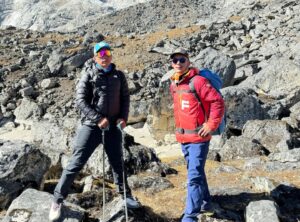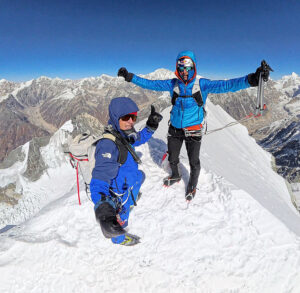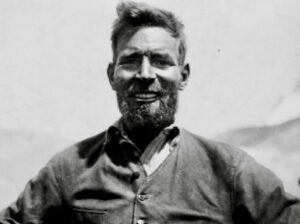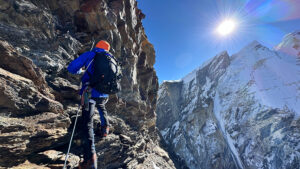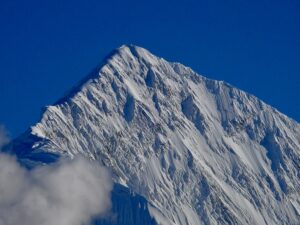Faking a summit picture on an 8,000’er is bad enough, but…Mera Peak? Seriously?
Abdul Rahim Al-Arjan of Jordan was one of many climbers last fall on 6,470m Mera, one of the most popular trekking peaks in Nepal. He reportedly summited on Oct. 26 and dedicated the triumph to his country’s monarch, King Abdullah.
Back in Kathmandu, Al-Arjan presented a “summit picture” to the Nepal Mountaineering Association (NMA). He duly received his summit certificate, The Himalayan Times reported.

Summit picture provided to the NMA. Photo: The Himalayan Times
Two pictures, both false
However, none of the three people in the summit photo was Al-Arjan, The Himalayan Times reported. Meanwhile, the (sort of) climber gave a different image to Jordan’s media: a closeup of him on some high place, which happened to be Mera’s high camp, midway between base camp and the top.
“Al-Arjan was very slow as he only reached the high camp and did not make it to the summit,” fellow climbers on the expedition told The Himalayan Times, although the newspaper cited no names. Some media back in Jordan covered Al-Arjan’s climb, but we have found no summit news or reports from the country’s English-speaking papers, nor interviews with the climber about his Himalayan experience.
High-altitude mountaineering is far from popular in Jordan, but Al-Arjan is not the first from his country to set foot in the Himalaya. The first Jordanian to summit Everest was Mostafa Salameh, on May 25, 2008, according to The Himalayan Database.
Summit certificates for everyone
Questioned on the controversy, NMA’s President Nima Nuru Sherpa said they will take the issue seriously and will investigate the images further. If Al-Arjan’s claims are found false, they will revoke the summit certificate.
“NMA has always been vigilant in safeguarding the authenticity of climbing achievements and preventing misleading claims,” Nima Nuru Sherpa said.
This is not the first time that climbers presented false evidence to the NMA and received summit certificates. In the most notorious case, two Indian climbers photoshopped themselves into someone else’s Everest summit photo. A denouncement from the expedition leader himself forced the Nepalese to investigate. Eventually, the climbers were banned from Nepal for two years. One of them, Narender Singh Yadav, later returned to the mountain and climbed it again, this time for real.

Al-Arjan’s summit certificate from Mera Peak. Photo: The Himalayan Times
Nepal authorities tend to grant certificates to everyone on the outfitter’s summit list. Denouncements from fellow climbers are extremely rare. Climbers pursuing firsts and records usually seek confirmation from respected research teams such as The Himalayan Database and 8000ers.com rather than just the NMA.
Nearly no one summits Mera
In fact, if we are going to speak of summit claims in a strict sense, there is more to it: Not only is Al-Arjan not one of the three individuals in the photo above…none of them are on Mera Peak’s actual highest point.
Mera is a straightforward climb and gives amazing views of Everest, Lhotse, Cho Oyu, and Makalu. However, it has three summit points. Most teams stop at the central summit (6,461m) and not the northern point, which is 15 meters higher.
According to an entry on SummitPost by Robin Baks in 2009, the reason for this is that there is an “enormous crevasse 30-40 meters below the summit.”
“You can only reach the summit from the north side,” SummitPost went on. “In order to do that, you’ll have to traverse the ridge on the left side of the summit and climb a very steep final ramp.”
According to Baks, that changed the difficulty scale from F (easy) to PD (slightly difficult). But as other climbers confirmed, the rope-fixers and climbers have stopped on the central summit since then.
“The (north) summit is marginally higher and another half-kilometer away, beyond most people at this stage,” said Jamie McGuinness of Project Himalaya.

The steepest section of Mera Peak usually has a fixed rope. Photo: Jamie McGuinness/Project Himalaya
North summit less steep but more dangerous
“Mera North is actually less steep than Mera Central and easier to climb, and…more likely to avalanche,” climber and author Mark Horrell says in a blog post about the mountain. “[It’s] therefore a better bet for more experienced climbers who move more quickly and are familiar with skills such as ice axe arrest.
“Do not expect to find any big commercial operators offering climbs of Mera North. To do this, you will need to find yourself a reliable trekking agency to provide you with the logistics and go independently.”

Approaching the two main summits of Mera Peak. Photo: Mark Horrell
With Manaslu, whose highest point commercial teams avoided for years, everything changed when drone footage clearly showed the true summit. Subsequent expeditions made sure they fixed ropes all the way to the very top.
With Mera, a humble trekking peak and the subject of no record quest, whether a climber reaches the actual highest point is not so strictly observed. However, the summit of any mountain remains its highest point.
Editor’s note: One day after this story appeared, Al-Arjan’s outfitter, Fourteen Summits, has formally asked the NMA to cancel their client’s summit certificate. They say that he provided a fake photo, according to The Himalayan Times.

